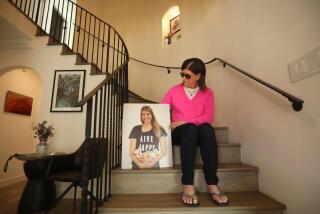Another Lifetime of Worry Over DES : Concern Grows That Onetime ‘Miracle Drug’ May Harm a Third Generation
- Share via
Judy Horton was only 29 when she had a hysterectomy after doctors discovered she had cervical cancer. Later, she had a benign lump removed from one of her breasts. Three years ago, she had both ovaries and her Fallopian tubes removed after an ovarian cyst ruptured.
“Now I am worried about my daughters,” says the 45-year-old Mission Viejo woman. Her eldest daughter, Kimberly, 25, has already had one miscarriage, and doctors have discovered an abnormality in her reproductive organs.
Having seen her mother battle cancer, Kimberly worries: “I wonder, ‘Is this going to happen to me?’ ”
The women’s concern is especially deep because Horton’s mother, Marillyn Myers, was given the synthetic hormone DES while pregnant with Judy in 1947. At the time, DES was considered a miracle worker, a drug that could prevent premature labor and miscarriages and could even build “bigger and stronger babies,” according to one drug company’s advertisement.
In 1971, the U.S. Food and Drug Administration restricted the use of DES, formally known as diethylstilbestrol, after it was linked to a rare form of cancer found in the children of women who had taken it while pregnant.
Although Horton has never developed clear cell adenocarcinoma, the only form of cancer directly linked to DES exposure, researchers for the National Cancer Institute believe “DES daughters,” such as Horton, may have an increased risk of developing other forms of cancer.
Now, a growing number of DES daughters, advocates and medical experts are calling for more research into the possible direct and indirect effects of DES on a third generation of women, as well as its continued impact on the second generation. Researchers insist no evidence supports the idea that DES can be passed to the grandchildren of those who took the drug, but the controversy persists.
This spring, a review of the latest medical research on DES will be conducted at a national conference sponsored by the National Cancer Institute, the National Institutes of Health, the National Institute of Environmental Health Sciences and the National Institute of Child Health and Human Development. Strategies for additional studies and public outreach also will be discussed.
“Further research is needed before we will know the full pattern of the drug’s effect,” says Dr. Ruthann Giusti of the National Cancer Institute. “It is critical that we maintain a registry of women who were exposed to DES and follow them . . . to accurately establish what their health experiences have been.
“Although there is no evidence that DES is passed down genetically to third generations,” Giusti says, there is an indirect link between the drug and third-generation babies born with serious handicaps caused by uterine and cervical abnormalities in the DES daughters.
The conference also will examine evidence from recent animal studies that suggest the drug may impair the body’s immune system. And it will study the reported recurrence of clear cell cancer in women who supposedly had been cured years earlier, according to Dr. Shanna Swan, chief of the reproductive epidemiology program at the state Department of Health in Berkeley.
In addition, Rep. Louise M. Slaughter (D-N.Y.) last week introduced legislation asking for $2 million for education and outreach programs to inform the public about the risks of DES exposure and the need to seek medical examinations and treatment.
“Most legislators . . . and members of the public are not aware of this problem,” Slaughter says. “There are millions of sufferers, and there may be generations we weren’t even prepared to think about.”
During the more than 20 years since the FDA barred doctors from giving DES to pregnant women, the controversy has led to more than 1,000 lawsuits against drug companies and has spawned support groups and advocacy organizations to help those exposed to the drug and to educate the public.
DES Action, a consumer group based in Oakland, has been pushing for more DES research, while the DES Cancer Network, with headquarters in Rochester, N.Y., offers support and information for clear cell cancer victims. A meeting to form a Southern California chapter of DES Action is planned on Feb. 23 in Westwood.
“The DES story is the prototype of a wonder drug gone wrong. It was a pharmaceutical disaster,” says Margaret Lee Braun, head of DES Cancer Network.
Although critics of DES contend that pharmaceutical companies failed to adequately test the drug before marketing it, a spokeswoman for Eli Lilly & Co., a major supplier of the drug, says that is not true.
“Eli Lilly & Co. believes that it acted responsibly in the development and marketing of DES, and we will continue to vigorously defend that position,” says the spokeswoman, Bette Peterson. “Lilly and independent investigators have conducted a variety of studies involving substantial testing and research that have contributed to making DES one of the most studied substances in history.”
Lilly didn’t market the drug until 1947, nine years after it was synthesized, Peterson says. “During those nine years, extensive testing and research was conducted by independent scientists and physicians who determined that DES was an effective therapy in saving babies who would have been lost and that this therapy did not harm the mother or the fetus.”
In response to concern over a possible third-generation link, Peterson said in a statement:
“There has not been any credible scientific suggestion that DES caused genetic injuries to the grandchildren of women who ingested DES during pregnancy. The third-generation claims now being asserted by a few plaintiffs’ attorneys allege injuries resulting from premature births and do not involve claims of genetic damage or defect due to DES exposure.”
Eli Lilly and other drug firms have been sued by hundreds of women who believe they were harmed by their exposure to the drug.
Last October, a New York state jury slapped Eli Lilly with a $12.2-million verdict--an amount believed to be the largest award in a DES case--in a suit involving a woman whose cancer and infertility was linked to her mother’s use of the anti-miscarriage drug. As the jury was about to decide whether the company should also pay punitive damages, the two sides settled out of court.
Terms of the settlement were kept confidential, but the case is expected to trigger drug companies to settle hundreds of other suits over DES. Besides Eli Lilly, which had about 75% of the drug’s market, other firms targeted in lawsuits include American Pharmaceutical, Boyle & Co., Rexall Drug & Chemical, E. R. Squibb & Sons and Upjohn.
Because a direct link has been established between DES and clear cell cancer--one out of every 1,000 DES daughters will develop such cancer--these cases are the strongest ones to litigate, according to attorneys who specialize in DES lawsuits.
Other cases, which are not so clear-cut, involve the third generation.
One such case is that of Iris Rosenfeld, a DES daughter who gave birth prematurely to a girl with physical handicaps.
Rosenfeld has filed a lawsuit in Los Angeles on behalf of her now 5-year-old daughter, Lara, against the manufacturers of DES. The lawsuit, still pending in Los Angeles Superior Court, alleges that Rosenfeld’s exposure to the drug in utero in 1955 resulted in abnormalities in her reproductive organs, which in turn led to the baby’s premature birth and handicaps.
Rosenfeld gave birth to Lara on Christmas Day, 1986, at Fountain Valley Regional Hospital and Medical Center. Two months premature, Lara weighed just 3 1/2 pounds. Her lungs were seriously underdeveloped, and her chances for survival looked bleak.
When Lara was 4 days old, she underwent open-heart surgery. A couple of days later, she was treated for hydrocephalus caused by bleeding in her brain. Weeks later, a shunt was put into her brain to drain cerebral fluid.
“I was petrified. I thought, ‘This can’t be true.’ I was living a nightmare,” Rosenfeld, 35, recalls.
But the infant survived and was released from the hospital when she was 2 months old.
Her problems haven’t ended, however. When she was 2 years old, doctors diagnosed cerebral palsy.
Today, Lara is a bright girl who plays Junior Monopoly with her mother. But physically, she is severely handicapped and must use a wheelchair or walk with the help of braces and a walker. She spends many hours a week in physical therapy.
Braun, of the DES Cancer Network, says cases such as Rosenfeld’s prove that “the DES nightmare continues.”
Although the numbers are small, other such cases exist nationwide involving DES daughters whose babies have serious problems because of reproductive abnormalities or premature birth, according to Roman Silberfeld, a Los Angeles attorney who specializes in DES litigation.
From 40% to 60% of DES daughters have some form of benign abnormality in their reproductive organs, according to the National Cancer Institute’s Giusti, making them a higher risk for premature or protracted labor, which can result in problems at birth.
But Giusti notes: “At this time, there is no evidence that the risk of birth defects, other abnormalities or cancer is any greater for children born of DES-exposed daughters and sons than for other children.”
Pat Cody, a DES mother and a program director of the DES Action League, recalls: “My heart sank like a stone when I first read the news report” about the link between DES and cancer. “I felt terrible.”
Cody, 68, took the drug when she was pregnant with her daughter, Martha. She had had one miscarriage, and her doctor prescribed DES in hope of preventing another.
“Back in the ‘50s, there was ready acceptance of the drug,” she says. “Society viewed it as another miracle drug. I took the drug four times a day for seven months. The attitude back then was ‘Better safe than sorry.’ ”
Cody was terrified when her daughter began having problems related to the DES exposure. First, Martha had an ectopic pregnancy and lost one of her Fallopian tubes. Later she developed such a severe case of endometriosis that she had to have a complete hysterectomy at age 34.
Her fear hits a common concern among DES daughters, who worry about how the issue has affected their mothers emotionally.
“I’m very protective of my mother,” says Horton. “I know our mothers carry a lot of guilt. I know it is hard on my mother and father every time I’ve had to go to the hospital for all the surgery.
“I want to assure my mother and others who took the drug that we (daughters) understand that they really didn’t know what they were doing” when they took the DES prescribed for them.






